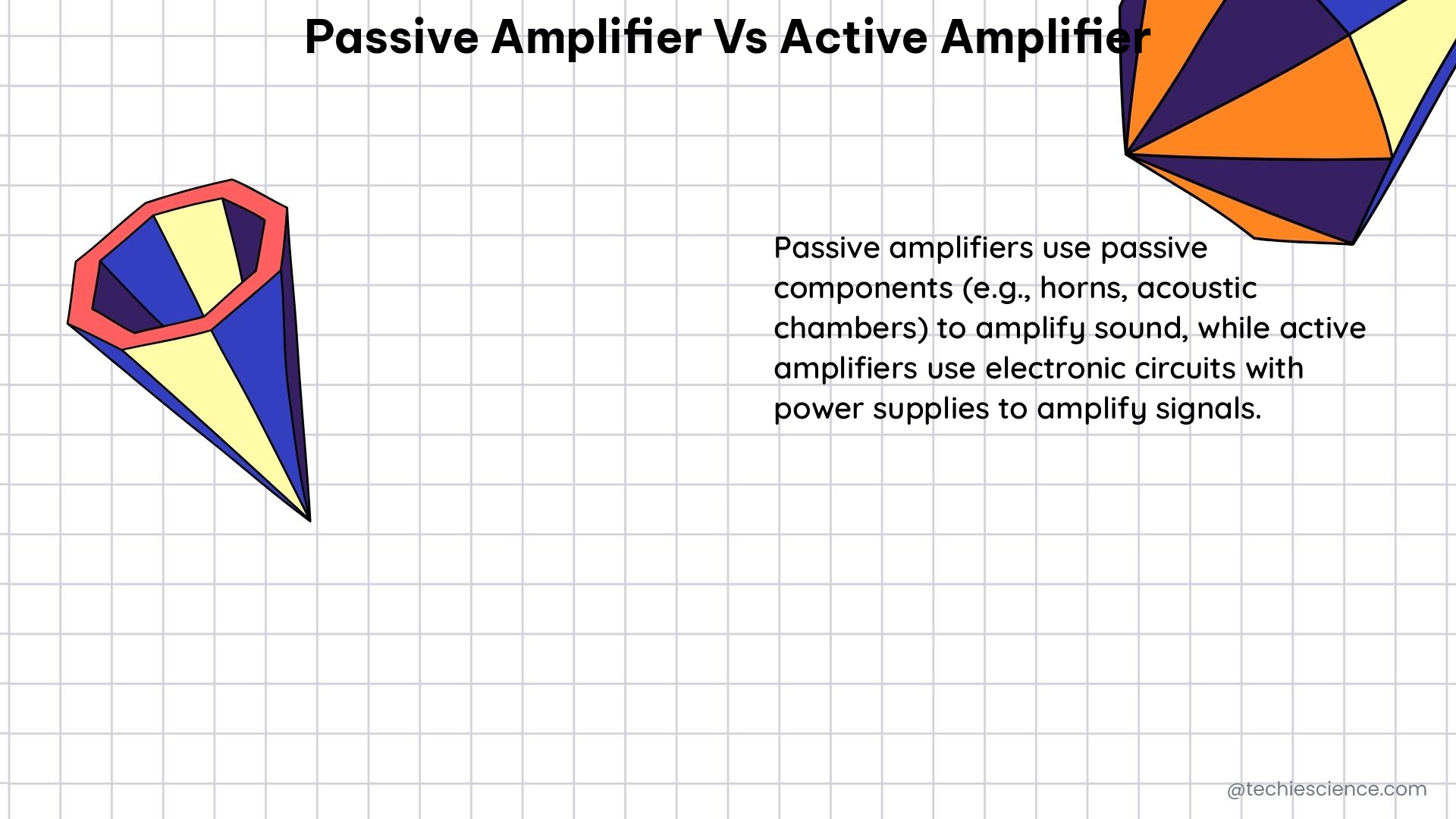Passive amplifiers and active amplifiers are two distinct types of audio amplification systems, each with its own unique characteristics and applications. This comprehensive guide delves into the technical specifications, theoretical explanations, and practical examples that highlight the key differences between these two amplifier types, providing a valuable resource for electronics students and enthusiasts.
Passive Amplifiers: Harnessing Impedance Matching and Voltage Division
Passive amplifiers operate on the principle of impedance matching and voltage division, without the need for an external power source. They rely solely on the energy of the input signal to amplify the audio. Understanding the underlying theory and the associated electronics formulas is crucial in comprehending the behavior of passive amplifiers.
Theorem: Impedance Matching and Voltage Division
The gain of a passive amplifier is determined by the impedance matching between the input and output, as well as the voltage division within the circuit. The gain can be calculated using the following formula:
Gain = (R2 / (R1 + R2)) * (Zin / (Zin + Zout))
Where:
– R1 and R2 are the resistor values in the circuit
– Zin is the input impedance
– Zout is the output impedance
Electronics Examples: Transformer-based and Resistor-Capacitor Networks
Passive amplifier circuits can be implemented using a variety of components, such as transformers or networks of resistors and capacitors. These simple circuits provide a fixed gain determined by the circuit’s design and the values of its components.
Numerical Problem: Calculating Passive Amplifier Gain
Consider a passive amplifier with the following parameters:
– R1 = 100 Ω
– R2 = 200 Ω
– Zin = 500 Ω
– Zout = 1000 Ω
Using the gain formula, we can calculate the amplifier’s gain:
Gain = (200 / (100 + 200)) * (500 / (500 + 1000)) = 0.167 or -8.69 dB
Figures, Data Points, and Measurements
Passive amplifiers have a fixed gain determined by the circuit’s components. They do not introduce additional noise to the signal but can cause distortion due to impedance mismatches. Passive amplifiers typically have lower output power and higher output impedance compared to active amplifiers.
Active Amplifiers: Leveraging External Power for Adjustable Gain

Active amplifiers, on the other hand, utilize an external power source to amplify the audio signal. They offer the ability to provide gain, buffering, and equalization capabilities, making them more versatile than passive amplifiers.
Theorem: Amplification with External Power
The key difference between passive and active amplifiers is the use of an external power source. Active amplifiers harness this power to amplify the input signal, enabling them to provide adjustable gain and other advanced features.
Electronics Formula: Calculating Active Amplifier Gain
The gain of an active amplifier can be calculated using the following formula:
Gain = 1 + (R2 / R1)
Where:
– R1 and R2 are the resistor values in the circuit
Electronics Examples: Operational Amplifiers, Transistors, and Vacuum Tubes
Active amplifiers can be implemented using a variety of active components, such as operational amplifiers (op-amps), transistors, or vacuum tubes. These active devices, combined with supporting circuitry, provide the necessary amplification and signal processing capabilities.
Numerical Problem: Calculating Active Amplifier Gain
Consider an active amplifier with the following resistor values:
– R1 = 1 kΩ
– R2 = 10 kΩ
Using the gain formula, we can calculate the amplifier’s gain:
Gain = 1 + (10000 / 1000) = 11 or 20.71 dB
Figures, Data Points, and Measurements
Active amplifiers can provide adjustable gain, higher output power, and lower output impedance compared to passive amplifiers. However, they may introduce additional noise and distortion due to the power supply and active components used in their design.
Passive Amplifier vs. Active Amplifier: Technical Specifications Comparison
To summarize the key differences between passive and active amplifiers, let’s compare their technical specifications in a tabular format:
| Specification | Passive Amplifier | Active Amplifier |
|---|---|---|
| Gain | Fixed, determined by circuit components | Adjustable, determined by external power source and circuit components |
| Noise | No additional noise introduced | Introduces noise due to power supply and active components |
| Distortion | Introduces distortion due to impedance mismatches | Introduces distortion due to power supply and active components |
| Output Power | Lower output power | Higher output power |
| Output Impedance | Higher output impedance | Lower output impedance |
| Power Supply | No external power supply required | Requires an external power supply |
| Complexity | Simpler circuit design | More complex circuit design |
This comprehensive comparison highlights the distinct characteristics and trade-offs between passive and active amplifiers, allowing you to make informed decisions based on your specific audio system requirements and design constraints.
References
- Active vs. passive – PS Audio: https://www.psaudio.com/blogs/pauls-posts/active-vs-passive
- Passive vs Active EQ on amps – what the pros and cons? – Basschat: https://www.basschat.co.uk/topic/270546-passive-vs-active-eq-on-amps-what-the-pros-and-cons/
- Difference between an active and a passive preamp: https://forum.audiogon.com/discussions/difference-between-an-active-and-a-passive-preamp

The lambdageeks.com Core SME Team is a group of experienced subject matter experts from diverse scientific and technical fields including Physics, Chemistry, Technology,Electronics & Electrical Engineering, Automotive, Mechanical Engineering. Our team collaborates to create high-quality, well-researched articles on a wide range of science and technology topics for the lambdageeks.com website.
All Our Senior SME are having more than 7 Years of experience in the respective fields . They are either Working Industry Professionals or assocaited With different Universities. Refer Our Authors Page to get to know About our Core SMEs.